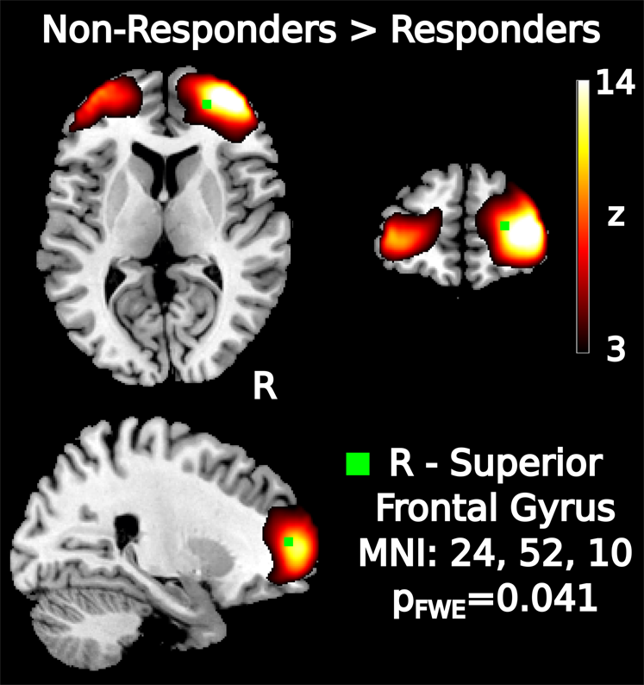当前位置:
X-MOL 学术
›
Transl. Psychiaty
›
论文详情
Our official English website, www.x-mol.net, welcomes your
feedback! (Note: you will need to create a separate account there.)
Individual prediction of psychotherapy outcome in posttraumatic stress disorder using neuroimaging data.
Translational Psychiatry ( IF 5.8 ) Pub Date : 2019-12-02 , DOI: 10.1038/s41398-019-0663-7 Paul Zhutovsky 1, 2 , Rajat M Thomas 1, 2 , Miranda Olff 1, 3 , Sanne J H van Rooij 4 , Mitzy Kennis 5 , Guido A van Wingen 1, 2 , Elbert Geuze 6, 7
Translational Psychiatry ( IF 5.8 ) Pub Date : 2019-12-02 , DOI: 10.1038/s41398-019-0663-7 Paul Zhutovsky 1, 2 , Rajat M Thomas 1, 2 , Miranda Olff 1, 3 , Sanne J H van Rooij 4 , Mitzy Kennis 5 , Guido A van Wingen 1, 2 , Elbert Geuze 6, 7
Affiliation

|
Trauma-focused psychotherapy is the first-line treatment for posttraumatic stress disorder (PTSD) but 30-50% of patients do not benefit sufficiently. We investigated whether structural and resting-state functional magnetic resonance imaging (MRI/rs-fMRI) data could distinguish between treatment responders and non-responders on the group and individual level. Forty-four male veterans with PTSD underwent baseline scanning followed by trauma-focused psychotherapy. Voxel-wise gray matter volumes were extracted from the structural MRI data and resting-state networks (RSNs) were calculated from rs-fMRI data using independent component analysis. Data were used to detect differences between responders and non-responders on the group level using permutation testing, and the single-subject level using Gaussian process classification with cross-validation. A RSN centered on the bilateral superior frontal gyrus differed between responders and non-responder groups (PFWE < 0.05) while a RSN centered on the pre-supplementary motor area distinguished between responders and non-responders on an individual-level with 81.4% accuracy (P < 0.001, 84.8% sensitivity, 78% specificity and AUC of 0.93). No significant single-subject classification or group differences were observed for gray matter volume. This proof-of-concept study demonstrates the feasibility of using rs-fMRI to develop neuroimaging biomarkers for treatment response, which could enable personalized treatment of patients with PTSD.
中文翻译:

使用神经影像学数据对创伤后应激障碍心理治疗结果的个体预测。
创伤心理治疗是创伤后应激障碍(PTSD)的一线治疗,但30-50%的患者不能充分受益。我们调查了结构和静止状态功能磁共振成像(MRI / rs-fMRI)数据是否可以在组和个人水平上区分治疗反应者和非反应者。对44名患有PTSD的男性退伍军人进行了基线扫描,然后进行了针对创伤的心理治疗。从结构MRI数据中提取体素方向的灰质体积,并使用独立分量分析从rs-fMRI数据中计算出静止状态网络(RSN)。数据用于使用置换测试在组级别上检测响应者和非响应者之间的差异,并使用具有交叉验证的高斯过程分类来检测单对象级别。响应者和非响应者组之间,以双侧上额额回为中心的RSN有所不同(PFWE <0.05),而以个体水平区分响应者和非响应者的补充前运动区域为中心的RSN,准确度为81.4%( P <0.001,敏感性为84.8%,特异性为78%,AUC为0.93)。灰质体积没有观察到明显的单项分类或组别差异。这项概念验证研究证明了使用rs-fMRI开发神经影像生物标记物以进行治疗反应的可行性,这可以使PTSD患者得到个性化治疗。05),而RSN则以补充水平为中心,在个人水平上区分了反应者和非反应者,准确度为81.4%(P <0.001,灵敏度为84.8%,特异性为78%,AUC为0.93)。灰质体积没有观察到明显的单项分类或组别差异。这项概念验证研究证明了使用rs-fMRI开发神经影像生物标记物以进行治疗反应的可行性,这可以使PTSD患者得到个性化治疗。05),而RSN则以补充水平为中心,在个人水平上区分了反应者和非反应者,准确度为81.4%(P <0.001,灵敏度为84.8%,特异性为78%,AUC为0.93)。灰质体积没有观察到明显的单项分类或组别差异。这项概念验证研究证明了使用rs-fMRI开发神经影像生物标记物以进行治疗反应的可行性,这可以使PTSD患者得到个性化治疗。
更新日期:2019-12-02
中文翻译:

使用神经影像学数据对创伤后应激障碍心理治疗结果的个体预测。
创伤心理治疗是创伤后应激障碍(PTSD)的一线治疗,但30-50%的患者不能充分受益。我们调查了结构和静止状态功能磁共振成像(MRI / rs-fMRI)数据是否可以在组和个人水平上区分治疗反应者和非反应者。对44名患有PTSD的男性退伍军人进行了基线扫描,然后进行了针对创伤的心理治疗。从结构MRI数据中提取体素方向的灰质体积,并使用独立分量分析从rs-fMRI数据中计算出静止状态网络(RSN)。数据用于使用置换测试在组级别上检测响应者和非响应者之间的差异,并使用具有交叉验证的高斯过程分类来检测单对象级别。响应者和非响应者组之间,以双侧上额额回为中心的RSN有所不同(PFWE <0.05),而以个体水平区分响应者和非响应者的补充前运动区域为中心的RSN,准确度为81.4%( P <0.001,敏感性为84.8%,特异性为78%,AUC为0.93)。灰质体积没有观察到明显的单项分类或组别差异。这项概念验证研究证明了使用rs-fMRI开发神经影像生物标记物以进行治疗反应的可行性,这可以使PTSD患者得到个性化治疗。05),而RSN则以补充水平为中心,在个人水平上区分了反应者和非反应者,准确度为81.4%(P <0.001,灵敏度为84.8%,特异性为78%,AUC为0.93)。灰质体积没有观察到明显的单项分类或组别差异。这项概念验证研究证明了使用rs-fMRI开发神经影像生物标记物以进行治疗反应的可行性,这可以使PTSD患者得到个性化治疗。05),而RSN则以补充水平为中心,在个人水平上区分了反应者和非反应者,准确度为81.4%(P <0.001,灵敏度为84.8%,特异性为78%,AUC为0.93)。灰质体积没有观察到明显的单项分类或组别差异。这项概念验证研究证明了使用rs-fMRI开发神经影像生物标记物以进行治疗反应的可行性,这可以使PTSD患者得到个性化治疗。











































 京公网安备 11010802027423号
京公网安备 11010802027423号